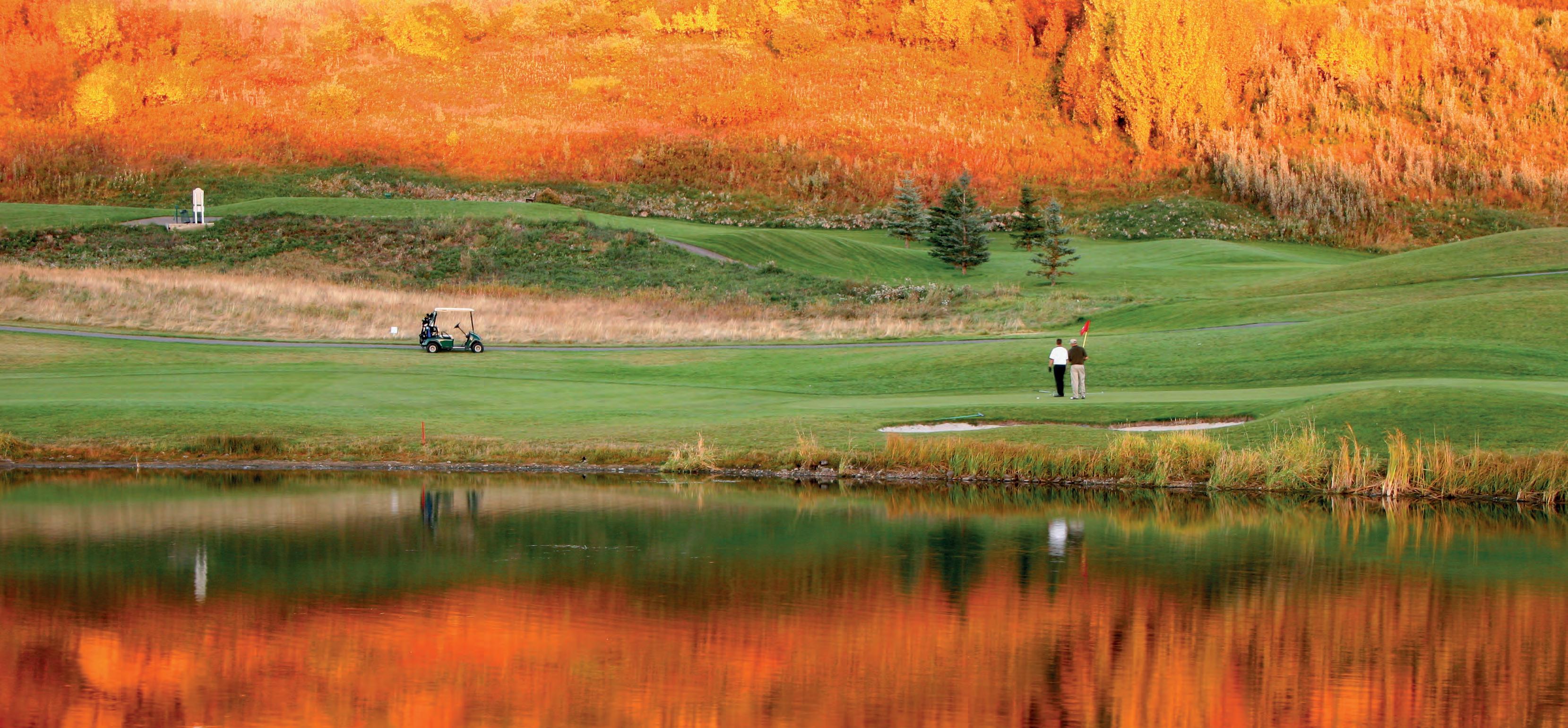
PREPARING TURFGRASS FOR WINTER
Preparing for the coming problems each Winter brings pg. 13
INSIDE THE ROPES pg. 17
SLEEP EASY pg. 24








Preparing for the coming problems each Winter brings pg. 13
INSIDE THE ROPES pg. 17
SLEEP EASY pg. 24






As we head into Autumn, we start preparing for the coming problems each Winter brings.
A look at the amount of time and effort that goes into controlling wear patterns on the golf course. 17
Our objectives include developing best practices to prevent and recover from winter injury.
As golf course superintendents and turf personnel, we are well acquainted with sleep…or the lack of it. 24

Atlantic Golf Superintendents Association
Membership Rates *
Class A & B $190
Corporate $220
Industry Affiliate $175
Student $60
Maintenance $60
4+ employees hired by a Class A $180
Ad & Article Deadlines
February (Supplier) January 1
May (Spring) April 1
July (Summer) June 15
October (Fall) September 15
Advertising Inquiries
AGSA Inc
571 Willow Avenue, Unit 1
President’s Message pg. 5
Service Tips pg. 8
Irrigation Corner pg. 11
Behind the Grass pg. 22


New Glasgow, NS B2H 2A1 www.agsa.ca
Executive Director
Jim Nix
1967agsa@gmail.com
Turf News Editor Jim Nix
Contributors
Matt Blackburn, Barry K Stone, Paul MacCormack, Jamie Matheson, John Dempsey, Jason Dziabel.
Photo
Berwick Heights Golf Club




"Overthepast4yearswehavehadtheprivilegeofworkingwithTurfMastersonourmasterplan. Theyhavebeenoutstanding.Thequalityofworkhasbeentothehigheststandard.Notaskor problemistoobig.Theowner,AndyStreatch,isareliableandprofessionalmanwithaskillset thatwillensureexcellentresults.Ourgolfcoursehasbeentakentoanotherlevellargelythanks totheconstructionexpertiseofTurfMasters.”
- Sue Crawford, Superintendent,


Blackburn | AGSA President
Many superintendents are relieved to see September arrive. The rain events have varied around Atlantic Canada over the summer. Some courses like us at Chester are very dry and have drained down their irrigation ponds. While others have been very wet. The pockets of rain all summer have been very localized, which seems to be the new normal.
Most of us have our Club Championships behind us and most major events as well. That being said, September can be a busy time for cooperate events. As a lot of us lose our summer labour force we need to be creative to figure out how to fill those gaps. That gets even more taxing as we tackle those fall cultural practices and any fall projects that are on the docket.
Our Atlantic Golf Superintendents Association Scramble was held at Northumberland Golf Links. We were hosted by Superintendent John Mills on what was a great day. Northumberland was hit hard by hurricane Fiona. The clean up John and his team did completely changed the feel of the golf course and opened up some amazing views of the Northumberland Strait. We had a record attendance and had a large number of club teams which was great to see.
It’s hard to believe that summer is over. It feels like it just started. We will be scheduling blowouts before you know it. Take the time to show your appreciation to your seasoned staff as they fill those gaps and get things put to bed in the upcoming months.
Matt Blackburn Superintendent Chester Golf Club AGSA President
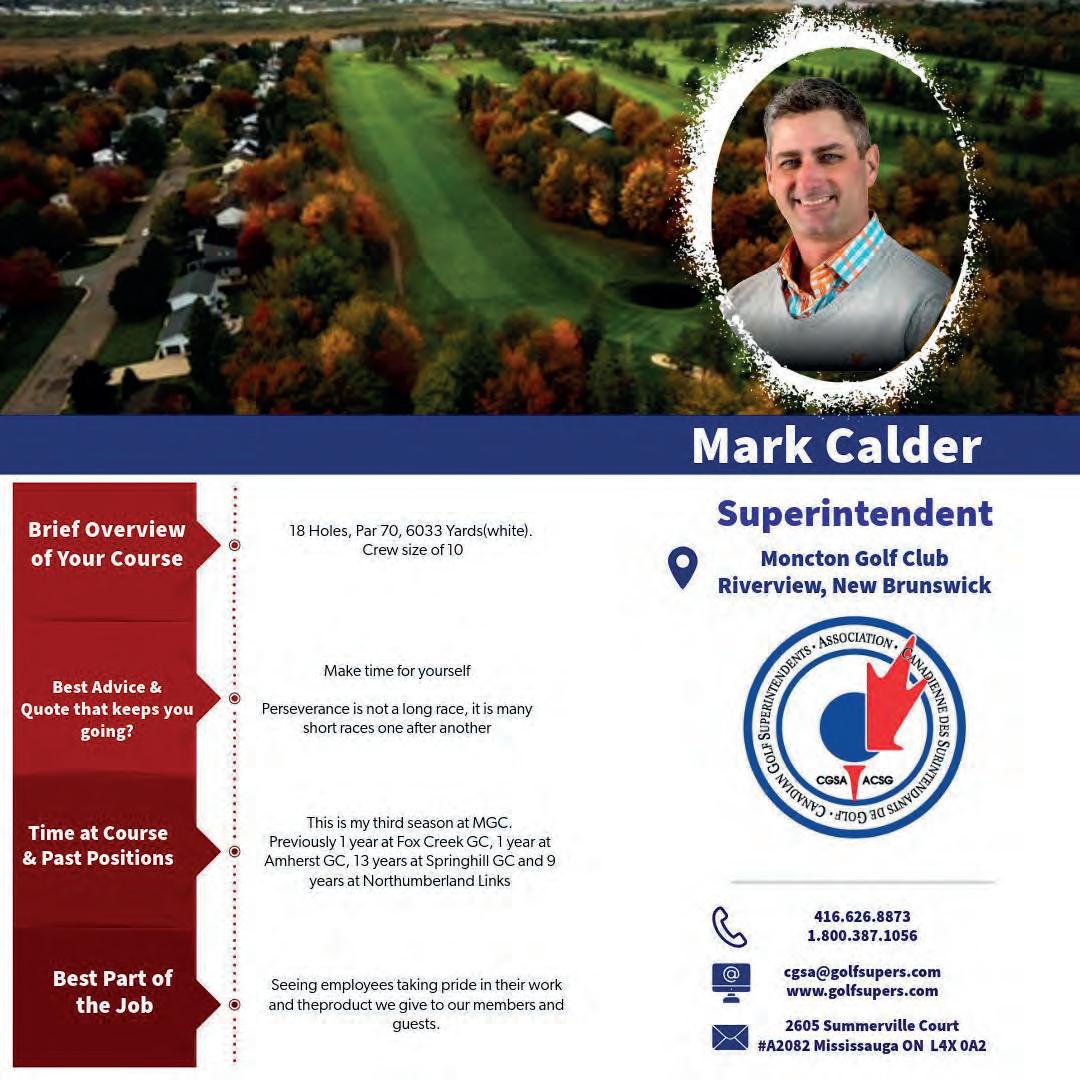

No matter what challenges your greens and fairways face throughout the year, Envu is ready with the right answer for your turf’s needs. Dedicate® Stressgard® fungicide delivers exceptional protection against all major snow moulds in Canada while also offering preventative control of in‑season diseases such as summer patch, anthracnose, dollar spot and leaf spot.



I have been pondering what the topic of this article should be after a busy summer and, as I was holding on to the rail to get down the stairs yesterday morning it dawned on me.
As mechanics we spend a lot of time watching the hour meters on our equipment and making sure they are getting the proper attention to ensure a long healthy life. We should be doing the same for our bodies.
I know in the busy summer I tend to grab that Toro fairway reel with the brushes and throw it on the bench myself, or not bother to run and get my proper ear protection for that little thirty second job with the air chisel. At 51 I am starting to feel the affects.
Cement is probably our worst enemy. I have a little garden mat I put under my knees when I am down changing reels. A day without using that and I can really feel it. I always make sure I have good boots. I know boots are expensive, but if you watch the sales sometimes you can get a good pair at a reasonable price.
Most of us are pretty good for eye and ear protection but we tend to forget about our lungs. When we pulled our reel and bedknife grinder, the wall behind it was just black with fine dust. We have a vacuum hooked to ours, but it still gets pretty dirty. I can’t see that fine dust being great for our lungs. I am also guilty of not wearing a mask when grinding, but I always wear one when cleaning the grinder.
Occupational Health and Safety has a lot of good tips for lifting. It will pay off in the long run.
Also make sure we keep our hand tools in good shape. Mushroomed chisels can be very dangerous. Make sure we keep them cleaned up. I have never personally seen
someone get a piece of a bad chisel in the eye, but have seen enough pictures to make me cautious.
Shop cleanliness is also an important part of safety. Every fall here at Brudenell-Dundarave we try to give at least one part of the shop a good cleaning and try to minimize the clutter.
We work hard to keep the equipment going so these golf courses look good.
Wouldn’t it be great to keep ourselves healthy enough to be able to enjoy them after retirement!!
As the season comes to an end, I keep a list of equipment that needs attention. I try to clean that list up before the start of a fresh season. Nothing worse than starting a new season with old problems. If your year-end budget is getting small, some companies have great fall booking programs. Some of these programs let you receive your parts now and pay in the spring. This will allow you to get these problems cleaned up before the new season begins in the spring.
Before unhooking your batteries, make sure they are charged up and clean. A dead battery will freeze before a fully charged one. The last few seasons on our rental fleet, we have been giving the batteries a good charge by cleaning them and applying a protective spray. It is really starting to pay off with the amount of battery problems we have during the season.
All the best to everyone !
Jamie Matheson Head Mechanic Brudenell River / Dundarave golf courses
Productivity, efficiency, simplicity and lighter weight, all packed into a compact chassis.The Reelmaster 3555-D was designed to be over 20% lighter, and much more compact than a traditional Toro fairway mower. The result is fairway mowers that deliver the performance you’ve come to expect from Toro, in a size that is highly maneuverable, and engineered to decrease turf compaction in sensitive areas.



Reelmaster 3555-D
Lightweight Design
Superior After-cut Appearance All-wheel Drive
Highly Maneuverable
Powerful & Fuel Efficient
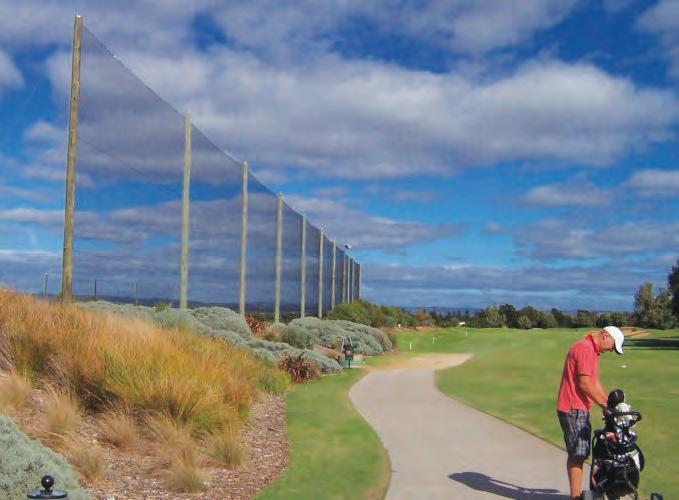










To learn more about Aqueduct Flex visit: Can.Aquatrols.com/Flex






As you travel the path of life there are sometimes aha occasions, my friends this is one of those occasions. I have chosen to speak on a different kind of water movement and there is no irrigation involved.
The topic of this issue is cancer, more precisely prostate cancer which I was diagnosed with in early spring of 2023 after having 12 core samples taken from my prostate.
The diagnosis was not a surprise as my PSA numbers had been climbing ever so slightly each year when I would get tested. With the first official word in 2023 from Dr Ross Mason and his wise words, I headed into the decision process of dealing with the problem. He felt I should wait 8 months then have another 12 cores removed, which we did. With the second set of core samples, it was clear that the cancer was becoming a bit more aggressive.
With this news Michelle and I met with Dr Mason in Feb 2024 and the decision was made to remove the prostate with Robotic Surgery after considering all 3 options which consisted of, doing nothing and wait for more advancement of the cancer, use a chemical means to control the cancer like radiation or chemotherapy, or have it surgically removed with Robotic Surgery. The decision was clearly to have Robotic Surgery which was done this month on n Sept 10. We were informed after the operation that everything went well. I still need to wait for the results of my biopsy in about 3 weeks to see if any further treatment is required.
The reason I am sharing this with our membership is very simple, not everyone gets their PSA checked yearly, even less request a physical exam. Here is the very important part of the message, I had no symptoms, no getting up to pee at night, no issues with pain or discomfort, no blood in my urine and no issues with intimacy, no pain in my groin area. By the time this cancer would have shown up with symptoms, I would have been too advanced for surgery, and possibly not controllable with chemical means.
Bottom line is to book a PSA test today, tell your friends, family, co-workers, every man you meet, no man needs to die from Prostate Cancer. It is the most studied cancer in Canada and one of the most curable.
Barry K. Stone CGIA


As we head into Autumn, turfgrass managers start thinking about and preparing for the coming problems each Winter brings regarding inclement and often hostile environmental conditions.
Winter conditions vary considerably, here in Ireland and the UK, winter conditions bring about mostly wet, consistently damp conditions, with minimal snow cover and temperatures only occasionally dropping below zero C. Ideal conditions for problems such as Microdochium patch, soft ground conditions and the ever-increasing problem with worm castings. In less temperate climates, such as Northern Europe, Canada, and USA, turfgrass managers often must deal with many weeks of continuous snow cover and extremely low temperatures, conditions allowing for devastating disease incidence and extreme damage from crown hydration and winter kill.


Winter survival of grass on golf greens is, primarily dependent on weather conditions. As such, there are many variables that are beyond the control of the greenkeeper. The Autumn period with its reduced level of play and favourable growing conditions after the Summer stress, allows turfgrass managers to focus on preparing for the approaching winter challenges.
While these preparations depend upon turfgrass species, geographic location, and local climate, many of the practices listed below are still good precautionary measures to take to safeguard your surfaces.
Light levels have a significant impact on turfgrass quality and development. Light is important for the acclimation of grass plants to winter stresses, turfgrass growing in shaded conditions during the Autumn will be poorly acclimated and less Winter stress tolerant. Inadequate light can lead to weakened swards with poor root systems and reduced reserves of energy. Turfgrass is slow to recover from wear and Winter injury, biotic challenge, and does not have the carbohydrate reserves to call on when Spring arrives. Afternoon shade during Winter can result in rapid refreezing and injury. Reduce shade by thinning canopies or removing trees, this can help significantly, with the bonus of improving air movement, resulting reduced disease pressures. The chain saw is one of the most important tools for greenkeepers!!

Autumn aeration is an excellent procedure to relieve surface compaction following a busy season of foot traffic, machinery pressure, and accumulations of excessive thatch. The conditions at this time of year allows for excellent recovery and the surfaces will be better able to withstand the coming challenges.
Combining this with a surfactant program will provide numerous benefits, turfgrass needs dry conditions to harden off properly for winter. A surfactant program can provide consistently drier and firmer surfaces, preventing dry down and hydrophobicity, it allows for enhanced photosynthesis and metabolic functions.

Drier leaf tissues equal less disease!
Increasing leaf surface area by raising mowing heights helps turfgrass generate and store energy for overwintering, as well as reducing stress. Stressed turfgrass is more susceptible to Winter injury than healthy turf! And the turfgrass has adequate carbohydrate stores to call on in Spring.
Nutritional inputs at this time of year should focus on turf health and not top growth! Avoid excessive nitrogen applications! Numerous programs are available which have proven success in ensuring healthy turf with good resistance to disease and abiotic stress. Apart from low N inputs, programs which contain Potassium, Manganese, Zinc, Phosphite, Calcium, Sulphur, Iron and Silica have all proven effective in this regard. Remember turfgrass that goes into winter weak won't come out of winter any stronger!
These are just a few suggestions to help prepare your turf for winter stress. The take home point is to ensure your turfgrass plants are as healthy as possible during autumn, this allows the strength to combat the coming challenges and provide reserves to kick start again the following Spring!
- John Dempsey
ALBATROSS:

• Consulting Services
• Irrigation Electrical Troubleshooting, Installation & Repair
- Wire and Valve Locating
- Fault Finding
• Soil Moisture Monitoring & Sprinkler Audits
• Sprayer Calibration
• 10 Complete Soil Samples
• Pest & Fertilizer Tracking & Programming
• Minimum 4 Site Visits
• 24/7 Phone Support
• Regular Atlantic Canadian Turfgrass related emails
EAGLE: BIRDIE:
• Consulting Services
• 5 Complete Soil Samples
• Minimum 2 Site Visit
• Regular Atlantic Canadian Turfgrass related emails
• 10% Off Additional Services
• 1 Site Visit
• Regular Atlantic Canadian Turfgrass related emails
• 10% Off Additional Services
Club Car Carryall is an industry workhorse, renowned for its ease of use and day -in, day-out durability. With multiple models and accessories available, you’ll find the Carry All UTV that fits your course and works as hard as your crew.
Available in Electric, EFI Gas and now a powerful, durable, maintenance-free lithium-ion option with added benefits:
Maintenance free battery
Longer battery life: (designed to last up to 10 years)
More efficient charging: (up to 40% faster charge times)
Increased power and performance. Best in class hill climb power.
Lighter weight than lead acid powered vehicles.
Lithium battery capacity does not de-grade over time.















by
Inside the ropes and stakes…
The best untold story in golf course management, in my opinion, is the amount of time, strategy, and effort that go into controlling wear patterns on the golf course. I have always been intrigued on the various tactics and simple tricks other course managers deploy daily to help gain control of both mechanical and physical stress in and around playing surfaces.
Over the years, working with different turf grasses, resort, public or private and in different climates has been a lot of fun, and fescue is no different. Managing fescue in Atlantic Canada in a resort play setting has certainly been a learning curve in the early years, however very eye opening and interesting.
During the construction phase of the Cliffs course, it was fun to have those discussions with the shapers as we would talk potential traffic movement and maintenance strategy. The truth of the matter is that you will never know how effective your decisions are until you open the golf course for players to enjoy. At that time, traffic movement can be studied, and minor alterations be made. We just didn’t know how the fescue was going to perform from a traffic standpoint. It was scary in the early years however learning what we have, and implementing new strategies has ultimately given us a strong mature turfgrass stand. Were not out of the weeds, but certainly in much better shape.
Whenever changes are made, I think it’s a general rule of thumb that the original intent of the experience of the golf hole be left intact. Areas should be left visually appealing and not affect the way the hole is to be
played. I often sit and spend some time watching some groups move through a certain area of the course to understand their thinking. People watching at its best, with purpose. If there’s anything we do know about human nature, is that people will take a direct path, incredibly anywhere.
In society and the regular world, we are always going to have jaywalkers, cars cross the center line to pass another, and people getting up to wait at the airport gate without their zone being called upon. Perhaps I am overthinking it, but I find it interesting to understand this human nature and how it can be captured to help not only the golf course but increase the player enjoyment. There are so many trying to get, A to B, the quickest and most direct line they can.
In our situation, we encourage golfers to move across the putting surface with their pull carts. Breaking one of the most fundamental etiquette rules in golf on a putting green that we learn at an early age. To quote a great line in the movie Moneyball, “Adapt or Die”, and I am relating that to the turf of course, I don’t take it that seriously! Look at it like this, in a typical foursome, we rarely hit the ball in the same area. Some are left, some right, the occasional down the center. That proven concept has helped in managing traffic across the greens. Not many take the same path to get to their ball on a green or fairway, It’s A to B. Direct line. Eliminating the use of ropes and signage to guide groups around greens has helped our collars tremendously. We used to walk the turf right off in spots, with only 4–5-foot corridors. Now, those same areas are receiving 50-60% less traffic in my observations.

With the addition of entry and exit points in key areas of congested traffic, we have experienced much less hardship. Entry points to tee areas still suffers in areas because it’s a direct line to the tee space. This would be the only spots we would utilize some rope and stake, or signage to protect a worn area. The challenge with adding these pathway networks is giving the illusion that it’s the most direct route. Having them in the proper places, the flow will naturally disperse from where their ball is or golf bag placed. Eliminating the choke points is very hard but important. While initially these new pathway additions can take up labor time and money, we don’t find ourselves moving ropes and stakes around like we used to, it’s been worth the effort on that front.
Pictured the pathway network leaving our 11th tee. Its interesting to see these three pathway options to the fairway get used in each group. Again, from my observations, golfers who hit the ball left, take the left path. If they hit it right, they use the right path. Direct line, A to B. Then there’s also the situation where perhaps a hole was won in a tight match on the 10th green, and they don’t want to talk to each other, so they took separate ways. But at least they had that option!
I feel our greatest achievement of change has come at the green site for our second hole. The original site had one entry and exit for an area that feels and could be described as an island dune experience. With very subtle additions, we were able to create two more exits at the rear and an additional two entrances at the front of the green complex. Not only has the turf responded well to the traffic pattern change, but it has also helped the native Marram grass establish and thrive with less foot traffic.
I don’t carry around many ropes and stakes in my cart and I hope that continues to be the case. I think the fun part for me is trying to understand human nature greater and continue to look for best practices strategies to eliminate the time and money to repair these areas. What’s important will be making additional pathway entries and exits, to get people from A-B in the most direct line. I also know there isn’t a be-all end-all solution to traffic management, but let’s face it, managing traffic will always be a thing either on the golf course or not.
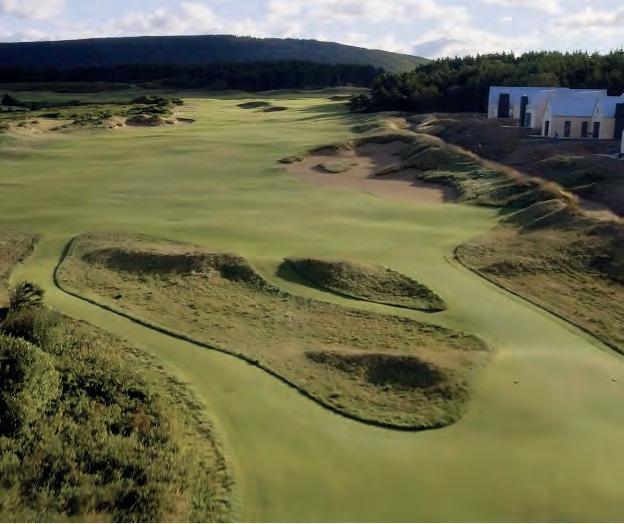









Polaro SC is a unique two-way snow mould combination designed and proven to withstand our Canadian winters. In over 100 trial locations across Canadian golf courses and at the University of WisconsinMadison, Polaro SC has proven to be a dependable snow mould control option providing exceptional results.




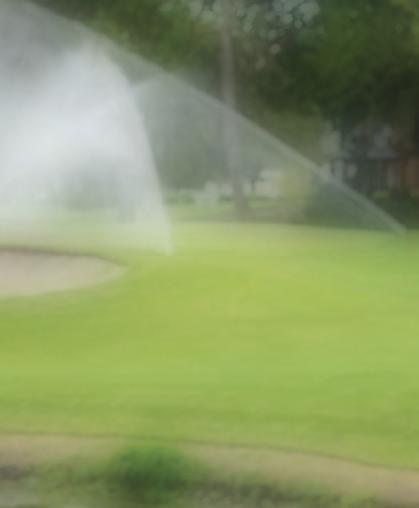






For the last three years, a team of researchers from across the U.S. and northern Europe have been working collaboratively to identify solutions to winter stress damage. Our objectives for this WinterTurf research project include developing best management practices to prevent and recover from winter injury, breeding more winter hardy turfgrass species, and exploring alternative snow mold control strategies, all in an effort to develop easy-toimplement solutions for turfgrass managers in cold climates.
We need your help. For this to be successful, we need to enlist the help of hundreds of golf courses located in cold climates throughout the world. Collecting data across many courses will allow us to discover the combinations of conditions that are responsible for damage, and even predict when damage might occur.
Please consider helping our team (and by extension, turfgrass managers across the globe) by signing up to collect data at your course over the 2024-2025 winter season. We’ll ask you to monitor at least one green throughout the winter – measure snow, take pictures, and record any other interesting observations on a regular basis. Early data modeling results are promising, and with your help we can make even more progress toward our ultimate goal of reducing the harmful effects of winter stresses on golf courses.
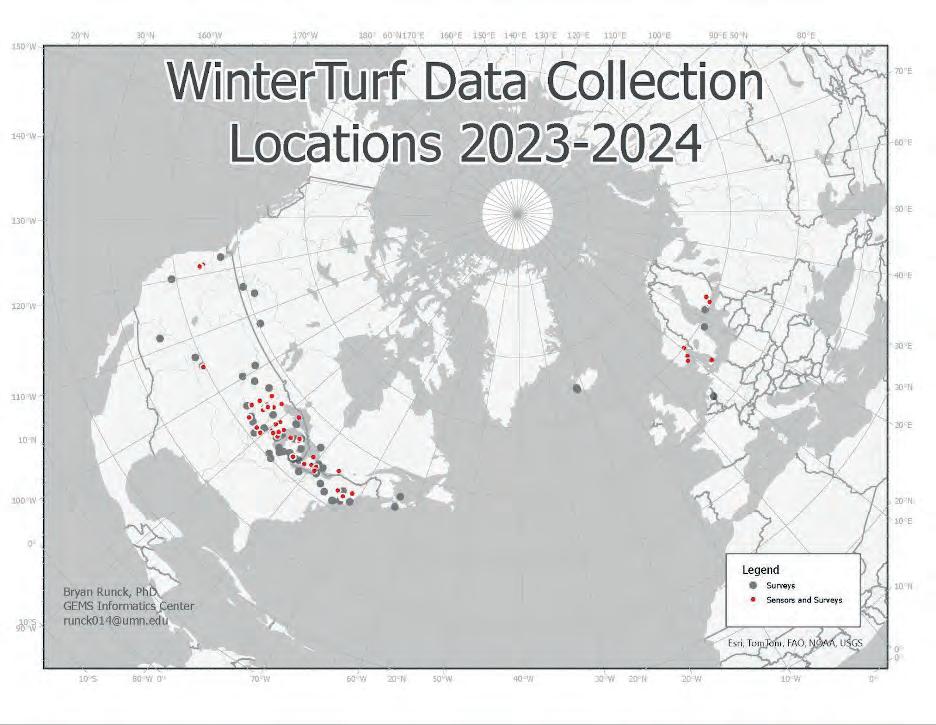
Figure description: Map showing golf courses where superintendents collected data last winter in support of the WinterTurf project. Courses marked in red also hosted environmental sensing units. To learn more about how to get a sensor placed on your course, go to z.umn.edu/sensors.

Note: The WinterTurf project is funded by the United States Department of Agriculture Specialty Crop Research Initiative and is a collaboration between several institutions: University of Minnesota, University of Wisconsin, University of Massachusetts, Michigan State University, Oregon State University, Iowa State University, Rutgers University, and the Norwegian Institute of Bioeconomy Research.
Please contact Paige Boyle at pboyle@umn.edu if you have questions.





We all do it. We’ve been doing it since the day we were born and will continue to do so until our final breath. When you think about it, we spend slightly less than half of our lives practicing this craft. We each have our own unique, idiosyncrasies and habits when it comes to what works best for us; the little things that only we know about which allow us to hopefully achieve the proper each day. It’s a part of our lives that is so completely underrated and misunderstood, and yet we cannot live without it. It’s sleep.
As golf course superintendents and turf personnel, we are well acquainted with sleep…or consequently, the lack of it. It’s usually around the middle of our respective seasons that we begin to notice the cumulative effects of lack of sleep. We grind and grind, waking at ungodly hours of the morning and then push ourselves through the rest of the day. Unfortunately, this pattern does nothing but harm to our overall health. Short of changing our careers, there isn’t much we can do to avoid the early mornings, but there are things we can do to ensure this accumulated sleep deficit doesn’t affect us negatively.
I recently read a fascinating book on the subject of sleep called, Why We Sleep: Unlocking the Power of Sleep and Dreams by Matthew Walker. It was a sobering read for someone as chronically sleep deprived as me because in the book Walker clearly explained that basically all essential biological processes which support our overall well being are affected by the quality of our sleep. Things like our diet, emotional regulation, learning and decision making and the overall health and functioning of our internal organs are all supported by sleep. The quality of our immune system and how quickly we heal from injury are impacted by how well we sleep.
The dangers of poor sleep are also thoroughly outlined in this book. Ironically there aren’t many of today’s modern maladies that are not worsened by poor sleep habits. From cancer, to diabetes, too many psychiatric illnesses…the effects of poor sleep are linked to them all. Not to mention the wider societal implications of something as simple as decision making. Vital decisions are being made on a daily basis by many folks who are not at the top of their game simply because they aren’t sleeping properly.
The other major issue that this book dealt with was how many accidents and fatalities are caused by fatigue and lack of sleep. The CDC shows that every hour in the US, someone is involved in a fatigue related accident. It’s odd how as a society we shame those who drive under the influence of drugs and/or alcohol, yet many of us drive when excessively fatigued each and every day.
This hit very close to home a week ago. A dear friend and colleague got a very upsetting call from his young adult son who was following him to work at the golf course for the weekend shift. Apparently he had fallen asleep, veered off the road, flipped the car multiple times and landed in the woods. Thankfully this young man walked away from the crash, but many are not so lucky. This sobering reminder of the dangers of driving while tired also hit me on an even more personal level. I drove the very same road on which this accident occurred countless times as a young man working my first assistant job. It was a grow in gig and as I reflect back on it now, it’s only through some divine hand that I didn’t succumb to a similar accident all those years ago given that I too fell asleep driving that road but I quickly awoke before an accident occurred.
So how are we, the turf community, to tackle this issue? The first step in finding a solution to any problem is to bring awareness and acceptance to the table. We first need to acknowledge that this is an issue. That’s a tough one, because ironically our industry does the opposite and tends to glorify the grind and the conditions that contribute to our poor sleep habits. It’s tough, believe me I know. I have worked a career in this industry and succumbed to the same harms as everyone else. Heck, I still fall prey to it and am left tired and fatigued on a daily basis.
For me, the most important step that I have taken is to prioritize my sleep. It has to get to the point where getting the requisite amount of sleep each day becomes non negotiable in your own mind. This is both an internal and external process. You have to place your intention on the process and then create the external conditions which support it. This can be as simple as room darkening shades or a sleep mask or ear buds to help facilitate sleep while it is still bright outside or as drastic as sleeping in a room or bed of your own if you usually share a bedroom with a partner.
Walker also presented some key things to focus on if you are interested in improving your sleep:
• Temperature control – our bodies need to drop 1-2 degrees internally to get a good nights’ sleep
• Darkness – we sleep better if the room we are in is in complete darkness
• Consistency – keeping a consistent schedule is very helpful
• Stimulation – keeping a wind down routine that is free from external stimulation is key (read…no screens)
• Physical exercise – regular exercise and a consistent stretching routine before bedtime go a long way to promoting quality sleep
• Quiet time – practices like meditation and reflection help to quiet our minds and help us to regulate our nervous systems which help us sleep more easily.
• The Nap – never underestimate the power of a solid nap.
While we can’t control the outcome of our lives, we can do things that create the conditions for an improved life now as well as improved longevity. This book states that one of the most important things we can do to promote well being and a fully lived life is to prioritize our sleep. The phrase “I’ll sleep when I’m dead” came up in the first chapter. Walker’s retort was, while that may be true, if we ignore our sleep the end may come a lot sooner than we wish.
Sweet dreams!
Thanks for reading,
Paul
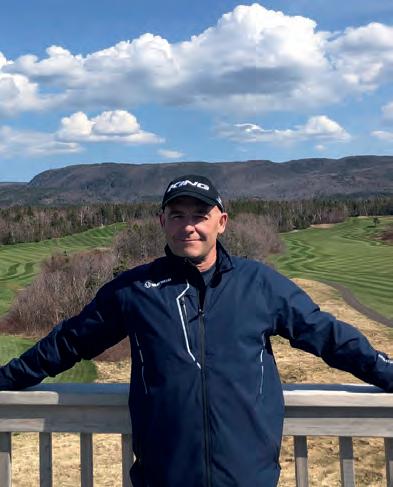







Let’s start with you Jennifer. Tell us a little bit about yourself
I am a first generation Canadian. My father emigrated from the Netherlands and my mother moved to NS from Wisconsin to marry my Dad. My father farmed with two brothers but eventually my dad bought a dairy farm in Somerset, NS. I am the oldest of five children including 3 brothers and 1 sister. Needless to say, I grew up working on the farm. I have two wonderful children, Jonathan and Morgan and a partner of 30 years, Everett. I attended NSAC (Nova Scotia Agriculture College) and studied Pant Science Technician. This was a broad spectrum course ranging from plant science to ornamental horticulture to turf management.
Have you always been in the golf business and if not, what did you do prior to this?
I have been in the golf business for 25 years now!! I have been a superintendent for the last 7 years, 5 at Paragon Golf Club and the last 2 at Berwick Heights. Originally, I was hired at Paragon as the course horticulturist and as such, I built and maintained all gardens, as well as growing all my own annuals for tee gardens, baskets and planters. Before getting into the golf business, I worked for two amazing women that ran a farm market/nursery locally and on the south shore. We grew most of the produce and plants we sold and trucked it to Tantallon three days a week while also being open in the valley.
Tell us a bit more about your move to Berwick Heights.
Well, I have been at Berwick Heights since June of 2023. Originally, I was going to have a season to get to know the people and the place itself but the acting superintendent ended up having to step down due to personal reasons so BAM..that was it. So this is in fact my first full season as Superintendent
What so far would you say has been or is your biggest challenge and what do you see as your potentially biggest challenge or challenges moving forward.

Although I have not had much time to think about it, so far, I can confidently say that drainage is something we will need to spend a lot of our effort on. It has become apparent that a big challenge moving forward is going to be finding enough people to work so that we can get that little extra maintenance done on the golf course. Like the drainage, there is always that something more pressing that gets in the way.
The superintendent’s role is not one that everyone would love and you need to love it. Getting up at ungodly hours, very long hours, very few days off and little time to enjoy the days of summer if you will. What has driven you to become a golf course superintendent? What are the one or two things that make it all worthwhile and have you had any particular mentor or person who has helped you along the way?
I think it comes from a background of growing things in my life. Not having been on the turf side of the business for many years, I have always been interested in the grass aspect of the course and asked questions. When being asked to try something, I gave it as shot and discovered that I liked it. I have been working outdoors and it is the greatest “office” in the world. Every day, I see a sunrise and interact with people who are happy to be golfing! Also, the encouragement of my family, telling me you can do this Mom/Jennifer. As far as one person who has played a big part of my becoming and continuing to be a superintendent, I would have to say Callum Haughn would be that person. He was always available to answer questions and took a lot of pictures if I was unsure what to do.
I suspect many of our readers have not been to Berwick Heights, since most of our AGSA members do not have a lot of time to get out and about in the summer months. I have heard your club’s journey to being was a little different from many. Can you share a little history of the Berwick Heights course with us?
Berwick Heights was built beginning in 1999 and completed in 2001. A local farmer at the time decided he would like to build a golf course and reached out to Stuart Lenthal-Ascot to help him build it. The course is set on the north side of the valley with an amazing view of the valley floor. It is clay based course with a links style until you get inside the course, where it is lined with hemlocks as well as having a huge ravine
that you will have to play over, as well as offering more stunning views. It’s similarity to links style comes from a demand for strategic shot making. The first few holes are particularly challenging, even for scratch golfers and require you to literally use every club in your bag at times. When the course started to have some financial trouble, a group including brothers George and Harley Moody, Carl Kennedy and Ray Parsons came together and changed the name from Valley Vista to Berwick Heights Golf Club. Upon the passing of Ray Parsons, his son Paul took over his father’s position on the BoD and in 2021, took upon himself to take over ownership of the course and by the end of 2022, he had full ownership.
As the season moves in to the fall, can you give us a little insight into your greens management plan looks like and how you will prepare for the upcoming winter
My fall preparation for greens will be taking a few soil samples, liming greens, and a deep tine for the first time ever. Then lots of sand and we will be using Instrata as our winter fungicide. Hopefully, we will also get to aerate and top dress tees as well.
I am not sure if you play some golf Jennifere but if you could play or at least visit any course in the world, which would it be?
If I could play only one course, like many people, it would be Augusta and I would love to see it as it prepares for the Masters.
What do you enjoy doing when you are not at the course?
I am usually home with my husband Everett and our dog Rudy. We have lots of lawn to mow and I love plants so we have a greenhouse for growing annuals for containers, baskets and window boxes. I do a little custom work on the side and I love making containers and such to give to friends. Walking Rudy and going for drives and watching sunsets are wonderful and I do love to read as well
As we move forward, it seems there are less and less people in our industry who are not there by design if you will. People like myself who just fell into the business for example and learned as we go, versus getting a diploma or a degree even in turf management. What would you say to a young person who was thinking about becoming a
superintendent? Would you encourage them to do so and how should they go about it? Also, the good, the bad, the ugly sort of thing as well.
I would say to a young person who was thinking about becoming a superintendent to start at the bottom. Get a summer job and do the work. If you don’t enjoy the work, you are probably not cut out to being a superintendent. As far as good, bad and ugly goes, I cant really say I look at it that way. Yeah, it sucks to get wet so buy a good rain suit and yeah, it sucks to get up at 4 am every day but it is so beautiful as the sun comes up and there is no traffic to deal with! The rest is just part of the job and I love it all.
Almost done. You are a fairly new AGSA member. Tell us what you see as the benefits of being a member
Being an AGSA member makes me feel like I am a part of a community of like minded people I do not even know. It also allows me to see what is going on out there through the website and Turf News magazine.
Second last question, since we can’t end on 13, especially today being Friday, the 13th of September. What is the management structure at your club. Are you an active member of the management team? I ask because although there have been many changes in the industry over the last 20 years or more, including having the superintendent being included as part of that team, there are still many who are not.
Our club is owned by Paul Parsons as I mentioned earlier. The GM, Gary McMullen, organizes the events schedule for the season, as well as oversees day to day operations. He and I work together and discuss what is going on
with the course and what needs to be done. We meet every day and Gary relies on my knowledge to make the right decisions for the conditions of the course. He often says “I don’t know how to grow grass” Honestly, I cannot imagine not being part of that management process.
Final comment/question and it may be broken up into a couple of parts when I do the final edit. I think it is fair to say being a golf course superintendent is a non-traditional role for women but I think we have made major strides in that area. Within the AGSA membership alone, we have some very successful female superintendents and assistants. Do you see us as an industry becoming more open and accepting of women in this role? Any thoughts on how to improve on the admittedly small strides we have made so far?
I am not really sure what to say about the industry being more open to women as “the industry” is really a nice way of saying “men” being more open to women being in the industry. I think if you are willing to do the work, the you gain the respect it takes to be a superintendent and a crew of mostly guys who are willing to do the work as well. My thoughts on how to improve the strides made so far? I think it is happening more than you think. People like Callum, Scott Shanks and Barry Stone for example are always willing to jump in and help. It has been a while since someone has shown up and asked me where the boss is…so there you go
Thanks very much Jennifer.

Turf

Gord Johansson,
Gord Johansson,
gordon.johansson@turfcare.ca






